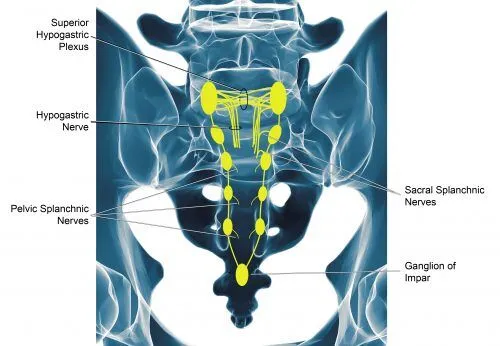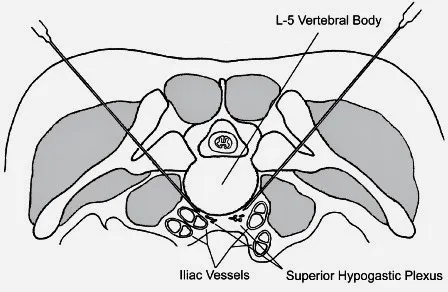Hypogastric Plexus Nerve Block / Neurolysis
Hypogastric Plexus Neurolysis
Pelvic pain from cancer can significantly impact your quality of life. If you’re living with this challenge, you may have heard about hypogastric plexus nerve blocks and neurolysis. This specialized procedure offers an effective solution to relieve severe pelvic pain caused by cancer or its treatments. Here we’ll explore what hypogastric plexus neurolysis is, how it works, and why it might be right for you. Additionally, we’ll highlight who can benefit from the procedure, its benefits, and what to expect during and after treatment.
What Is the Hypogastric Plexus?
The hypogastric plexus is a network of interconnected nerves located in the lower abdomen and pelvis. These nerves carry pain signals from the pelvic organs, including the bladder, rectum, and reproductive organs, to the brain. For example, in cases of advanced cervical or rectal cancer, tumors can compress or irritate these nerves, intensifying pain signals and making daily activities challenging. For patients with advanced cancers in these areas, the hypogastric plexus often becomes a major source of chronic pain.

What is a Hypogastric Plexus Nerve Block?
Hypogastric plexus nerve block is a procedure designed to disrupt pain signals traveling through the hypogastric plexus. During the procedure, a physician injects a chemical agent, such as alcohol or phenol, into the nerve plexus. This injection destroys nerve fibers, providing long-lasting pain relief. By targeting the nerve pathways with a hypogastric plexus nerve block, patients with cancer-related pelvic pain often experience significant improvements in daily life and comfort.
By targeting the nerves responsible for transmitting pain, hypogastric plexus neurolysis reduces or eliminates the discomfort associated with pelvic cancers. For many patients, this procedure restores the ability to focus on daily activities and improves overall well-being.
Who Benefits from Hypogastric Plexus Nerve Blocks?
Patients experiencing severe pelvic pain due to cancers of the pelvic region are ideal candidates for this treatment. Common conditions treated include:
-
Gynecologic cancers, such as cervical, ovarian, or uterine cancer.
-
Colorectal cancers affecting the lower bowel or rectum.
-
Prostate cancer that has advanced into the pelvic structures.
In addition, patients who do not find sufficient relief with traditional pain medications or who experience significant side effects from those medications may consider hypogastric plexus nerve blocks and neurolysis. Consulting with a pain specialist is crucial to determine whether this procedure is appropriate for your specific condition and medical history.
How Is the Procedure Performed?
A hypogastric plexus nerve block is a minimally invasive procedure that involves several key steps to ensure precision and effectiveness. Before starting, you will be positioned either face down or on your side, and a local anesthetic will numb the area to minimize discomfort. Using advanced imaging technology, such as fluoroscopy or CT scans, the doctor will carefully locate the hypogastric plexus to pinpoint the target area.
Once the location is confirmed, a fine needle is skillfully guided to the nerve plexus. Through this needle, the physician injects a chemical agent, such as alcohol or phenol, which works to disrupt the transmission of pain signals. This process directly targets the nerve pathways responsible for chronic pelvic pain.
After the injection, you will be monitored briefly to ensure there are no immediate complications. Most patients begin to feel significant relief from their pain within hours or days following the procedure. The results can last for several weeks to months, depending on the individual’s condition and response to treatment.

Hyogastric Plexus Nerve Block: Benefits
The benefits of this procedure are numerous, including:
-
-
Effective Pain Relief: Many patients experience significant reductions in pain levels, often enabling them to resume normal daily activities and improve their overall quality of life. This relief allows patients to focus on what matters most, such as spending time with loved ones or engaging in hobbies, without the constant distraction of severe pain.
-
Improved Quality of Life: With less pain, you can focus more on meaningful activities and relationships. Many patients notice improvements in their ability to move comfortably, enjoy hobbies, and sleep better. The reduction in pain often allows individuals to regain emotional stability and feel more present during social interactions. Whether it’s attending family gatherings, working, or simply enjoying everyday moments, the hypogastric plexus nerve block provides the opportunity to reclaim a sense of normalcy and fulfillment.
-
Reduction in Medication Use: After the procedure, many patients reduce their reliance on opioid pain medications. This decrease not only minimizes the risk of side effects like drowsiness, nausea, and dependency but also allows patients to feel more alert and engaged in their daily lives. For some, this means they can return to activities they previously avoided due to medication-related side effects, such as driving, working, or spending quality time with family and friends.
-
Minimally Invasive Approach: The procedure is outpatient-based and involves minimal recovery time. Since the entire process is performed using fine needles, patients leave the clinic with only a small band-aid covering the injection site. This minimally invasive nature reduces the risk of complications and ensures a faster return to daily activities.
-
Risks & Side Effects
Although hypogastric plexus neurolysis is generally safe, it carries some risks. Temporary soreness at the injection site is the most common side effect and usually resolves within a day or two. Transient changes in bowel or bladder function may occur in rare cases, but these typically resolve without further intervention. Complications like infection or bleeding are extremely rare due to the minimally invasive nature of the procedure. Your physician will discuss these risks in detail and take every precaution to ensure your safety, giving you confidence and peace of mind before undergoing treatment.
Preparing for Hypogastric Plexus Nerve Block
To prepare for the procedure, follow these steps:
-
-
Discuss your medical history, including current medications, with your provider.
-
Avoid eating or drinking for a few hours before the procedure as instructed.
-
Arrange for someone to drive you home afterward.
-
By following these guidelines, you can ensure a smooth experience.
What To Expect After the Procedure
Recovery from hypogastric plexus neurolysis is usually quick. You may feel mild discomfort at the injection site, which typically resolves within a day or two. Most patients resume normal activities shortly after the procedure. Pain relief often begins within a few days and can last for several months.
Your healthcare provider may recommend additional treatments, such as physical therapy or counseling, to complement the pain relief from the neurolysis. Regular follow-up appointments will help monitor your progress.
Frequently Asked Questions
How long does the pain relief last?
Pain relief from hypogastric plexus neurolysis varies but often lasts for several months. Studies show that the procedure has a success rate of approximately 70% to 90%, with many patients experiencing a reduction in pain levels by 50% or more. In some cases, the procedure can be repeated if the pain returns.
Is the procedure painful?
Most patients find the procedure tolerable. The local anesthetic used ensures minimal discomfort during the injection.
Can it be combined with other treatments?
Yes, hypogastric plexus neurolysis is often part of a comprehensive pain management plan that may include medications, physical therapy, or counseling.
Hypogastric Plexus Nerve Block: Is It Right for You?
If pelvic pain from cancer affects your life, hypogastric plexus neurolysis may provide the relief you need. This advanced procedure not only reduces pain but also helps restore functionality and improve your overall quality of life. At Red Butte Pain Solutions, we specialize in advanced treatments like hypogastric plexus neurolysis to help you regain control over your life. Contact us today at 602-633-4334 to schedule a consultation and explore how this procedure can be part of your personalized pain management plan.
Where Does It Hurt? Colon Cancer Pain Areas and Symptoms
Colon cancer is the second leading cause of cancer death in the United States. It often develops silently, and pain is typically a late symptom. This makes early detection and screening even more important. As the disease progresses, it can cause pain in specific...
When Are Coccyx and Buttock Pain Cancer Symptoms?
At Red Butte Pain Solutions, we frequently work alongside exceptional oncologists from across the Phoenix area to help patients manage cancer-related pain. Among the many types of pain experienced by cancer patients, coccyx (tailbone) and buttock pain are relatively...
Pelvic Cancer Pain: How Neurolysis Can Help
At Red Butte Pain Solutions, we know how hard pelvic cancer pain can be. Pain from ovarian cancer, colon cancer, and other pelvic cancers can stop you from doing everyday activities. I have helped many patients with this severe pain, and I want to tell you about a...
